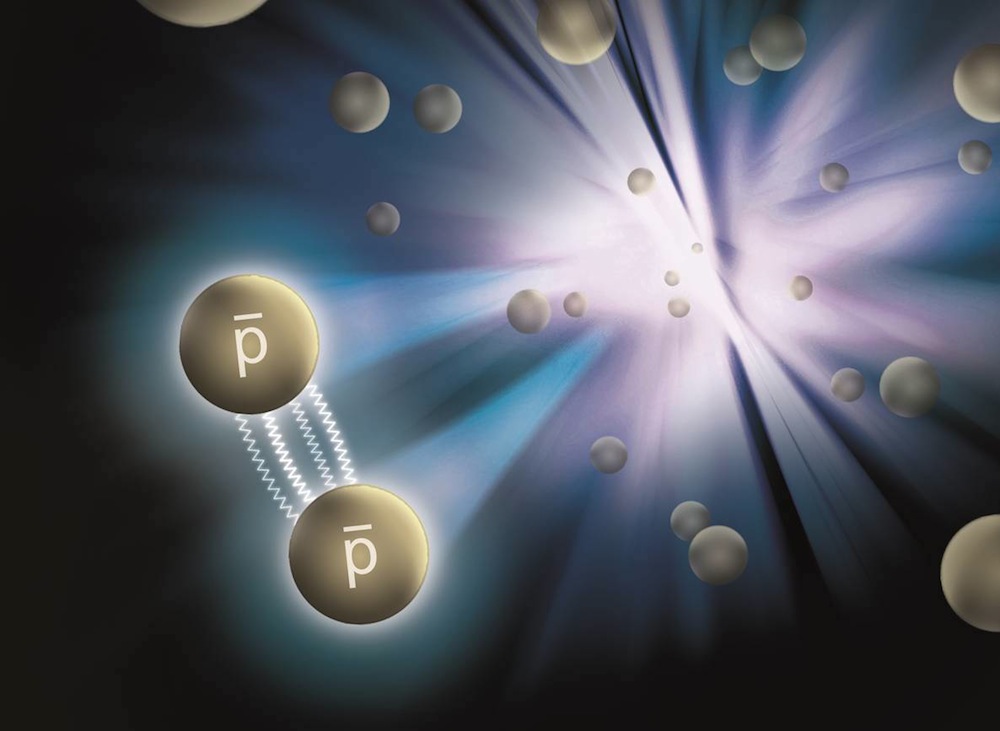'Mirror Universes' Might Look and Behave Like Ours, Study Finds

What's the difference between matter and antimatter? Sometimes nothing, a new study finds.
Scientists at Brookhaven National Laboratory's Relativistic Heavy Ion Collider (RHIC) discovered that antimatter protons, called antiprotons, act just like their ordinary-matter cousins when they are close enough to interact via the so-called strong nuclear force, which binds protons and neutrons together into atomic nuclei.
Antimatter is essentially the opposite of matter, in which the subatomic particles (protons and electrons) of antimatter have charges opposite to those of ordinary matter. In an ordinary block of stuff, for instance, the protons are positively charged, and the electrons carry negative charges. In antimatter, the antiprotons are negatively charged, while the antielectrons (called positrons) are positively charged. When antimatter and matter touch, they annihilate each other and produce energy in the form of gamma radiation. [The 9 Biggest Unsolved Mysteries in Physics]
One of the most puzzling mysteries in physics is why the universe has more matter than antimatter.
Most theories describing the origins of the universe suggest there should have been an equal amount of matter and antimatter created 13.5 billion years ago during the Big Bang. If that had happened, the world as we know it wouldn't exist. Instead, the whole universe would be filled with radiation because all the matter and antimatter would have been annihilated. But for some unknown reason, scientists have said, there was a tiny bit more matter than antimatter left over after the Big Bang, so after the initial annihilation, the leftover matter became all the things we see in the universe now.
"This is an unresolved puzzle," Aihong Tang, a Brookhaven physicist who worked on the new experiment, told Live Science. "If antiprotons interact differently, [that] could be a factor that needs to be taken into account."
To study these interactions, physicists look for differences in the way antimatter and matter behave, using particle accelerators like the RHIC to make antimatter. If matter and antimatter behave differently, then that could offer some insight into why matter dominates the universe. (Astronomers have searched for regions of the universe that may be dominated by antimatter left over from the early universe; if they exist, the boundaries between matter-dominated regions and antimatter regions would create gamma-rays. Thus far, though, observations made by NASA's Chandra X-ray Observatory and Compton Gamma Ray Observatory seem to rule out that possibility.)
Sign up for the Live Science daily newsletter now
Get the world’s most fascinating discoveries delivered straight to your inbox.
According to a theory called charge-parity (CP) symmetry, antimatter should look just like matter — a block of anti-iron or cloud of antihydrogen should behave the same way as its matter counterpart. Violations of that symmetry would mean that isn't the case. The RHIC experiment shows that, at least for the proton pairs, though, there isn't any charge-parity violation. This means that the phemomenon that made matter into the dominant form of stuff in the universe, probably wasn't some property of the antiproton interactions, Tang said.
Other experiments have found evidence of CP symmetry violations in more exotic types of particles, such as kaons or B mesons, but they aren't enough by themselves to explain the dominance of matter over antimatter. [5 Reasons We May Live in a Multiverse]
To measure antiproton interactions, the scientists fired gold nuclei at each other at nearly the speed of light. When the nuclei collided, they turned into a shower of subatomic particles, and among them were pairs of antiprotons.
Ordinarily protons, which carry the same electric charge, would repel each other, but when they are close enough, those forces become less important than the strong nuclear force, which binds the antiprotons together, just as it does for ordinary protons. That part was in line with expectations.
"We've effectively made antihelium-2," Tang said. Ordinary helium, or helium-4, is made of two protons and two neutrons, while helium-2 is just two protons with no neutrons.
Both antihelium-2 and helium-2 are unstable, meaning they decay quickly. However, the antihelium-2 lasted long enough for the researchers to see how the antiprotons interact. The experiment confirmed that the interactions between antiprotons were the same as those of protons.
Because antiprotons annihilate when they hit anything made of ordinary matter, within a fraction of a second, they usually hit the sides of the chamber that contains the collision of the gold nuclei that created them in the first place, and turn into gamma radiation.
The experiment verifies what is known as charge-parity-time (CPT) symmetry, an extension of CP symmetry that includes time. CPT symmetry says that, if you replace the charges with their opposite values, make particles into their mirror images and reverse time, physical laws will look the same — in other words, a "mirror universe" would look and behave just like ours.
There are instances where this symmetry is violated, but Tang noted that antimatter — or at least the kind of antimatter particles studied here — shouldn't be one of them. "Physicists always assumed what our experiment demonstrated," Tang said. "We verified CPT from a different angle."
The study's findings were published Nov. 4 in the journal Nature.
Follow Live Science @livescience, Facebook & Google+. Original article on Live Science.










